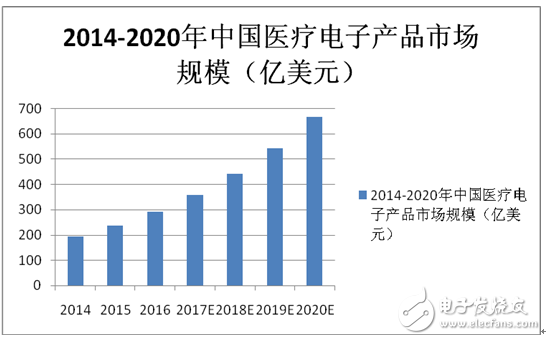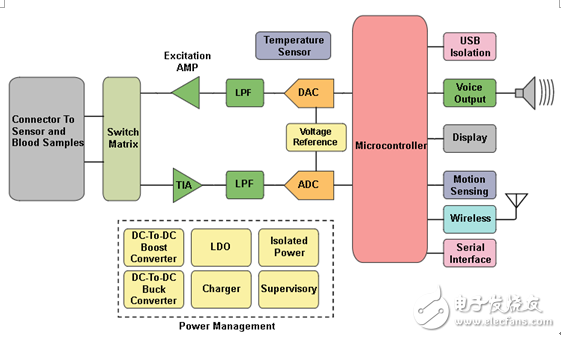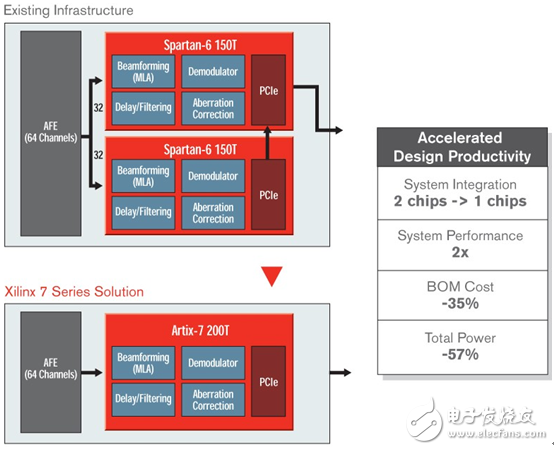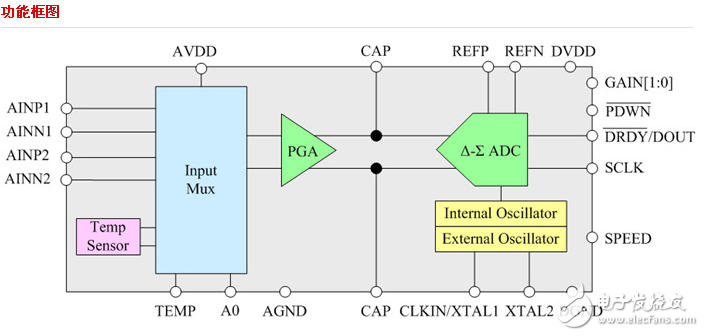Semiconductor products are the key factors for the improvement of core functions and performance of medical electronic products. The development of intelligent, remote and networked medical electronic products combines technologies such as data acquisition, low-power power management, and data transmission analysis to semiconductors. Component suppliers bring opportunities.
In 2014, the total market size of China's medical electronic products reached US$15.74 billion. In 2015 and 2016, it reached US$23.7 billion and US$29.1 billion respectively. It is estimated that the market size will reach US$66.6 billion by 2020.

Compared with consumer products, it is easy to form a bubble and quickly burst. Medical electronic products are a relatively stable market. Although the period from product development to certification is very long, the huge market prospect and stable return attract many semiconductor manufacturers. Participating, they are looking forward to mining gold mines from the medical electronics market. As a result, medical applications have become one of the fastest growing segments of the semiconductor market today.
Intel, Xilinx, Texas Instruments, STMicroelectronics, Jarno/Linglite, Renesas Electronics, NXP and ON Semiconductor are major suppliers of medical semiconductor products. They mainly provide core medical semiconductor products such as data acquisition ICs, power ICs, power devices, sensors, MCUs, FPGAs, and DSPs.
Changes from the medical field place higher demands on electronic technology. In the past, medical testing equipment focused on structural and functional issues, and future medical devices must provide more non-structural and non-functional predictive and detection information.
The TI blood pressure monitor can measure blood pressure using the Korotkov method, the oscillometric method, or the pulse transit time method. It uses pressure cuffs, pumps, and transducers to measure blood pressure and heart rate in three stages: inflation, measurement, and deflation. The blood pressure monitor includes an LCD, a selection button, a reset, a power management, and a USB interface.
Blood pressure monitor block diagram

ADI's design diagnostics are comparable to portable blood analyzer solutions for clinics and laboratory systems. Choose the highly integrated, low-power, on-chip meter, the ADuCM350, optimized for portable health applications. The ADuCM350 integrates a 16-bit precision analog front end (AFE), Cortex M3 processing subsystem, and industry standard software development environment, powered by coin cells. Complete discrete designs with ADI's extensive portfolio of standard converters, linear and mixed-signal components.
Portable blood analyzer program

Traditional analog and discrete logic devices have become increasingly incapable of meeting system design requirements, with higher integration and newer architectures to meet user needs. FPGA devices enable complex control and high-density digital signal processing when some MCUs are unable to meet demand. This system-level digital technology is driving innovation in medical imaging equipment.
Medical electronics demand high performance, connectivity, low power and low cost components. Xilinx's latest ArTIx-7 is optimized for these needs and offers FPGA-based CT scanners. Ultrasound diagnostic equipment solutions.
Xilinx Low Cost Ultrasound

China Core has a broad space for innovation, from consumer medical equipment to diagnostics, patient detection and treatment equipment to medical imaging. Almost all medical devices are inseparable from electronic technology. IT costs in medical equipment costs exceed 10% or more. In CT medical imaging equipment, electronic products account for 11% of total cost; in medical materials such as catheters, electronic components and materials account for more than 40%.
At present, medical equipment innovation is developing in the direction of low cost, high quality and high penetration rate. How to achieve more humanization and portability becomes the focus of medical equipment competition.
China is a big demand for medical instruments, but the domestic market is dominated by foreign equipment. Compared with foreign medical instruments, local manufacturers do not really have much innovation. The Chinese medical instrument industry needs to seize the opportunity of the country to promote new medical reforms to comprehensively enhance competitiveness.
Although there are currently hundreds of chip design companies in China, there are not many real attention and entry into the medical chip market. Market size and market demand are two important indicators that chip companies are paying attention to. Many chip design companies are discouraged because many medical segments lack demand for large-scale market support.
But medical system chips have revolutionized the innovation of the entire medical device market. At present, the medical equipment purchased by Chinese hospitals is expensive, mainly because most medical equipment cannot be manufactured in China. Once China can produce medical equipment by itself, foreign equipment will immediately cut prices. And if China's medical chips can provide more and better solutions, it will undoubtedly accelerate the innovation of China's medical system equipment companies, and let medical equipment cut prices significantly, so that the people will benefit. If Chinese medical chip companies can provide more and better solutions, they can promote the innovation of China's medical system equipment.
As a leading enterprise in the field of integrated circuits and health measurement in China, Xinhai Technology is guided by technological innovation and starts from the “core†to promote the continuous improvement of health end products. The company has always adhered to the independent research and development of products, and has continuously expanded from ADC products to SOC and MCU fields, and launched the first Bluetooth SOC chip in the health field. It is the first to launch the first 8-electrode BIA measurement chip in mass production. 20 measurements of human body signs have been supported.
In the future, aiming at health measurement and big data, Core Technology will continue to use chips as the first entry, from sensor to detection (ADC), control (MCU), communication (BLE/WiFi) and drive (LED/LCD). Driver's intelligent IC system, while providing intelligent IC+ algorithm + big data + standard services for the whole industry, digging deeper user data, connecting third parties to achieve personalized health services, truly realizing from the "core", depicting the future of good wisdom and health blueprint.
Core-sea high-precision 24-bit analog-to-digital converter (ADC):

The Shenzhen Institute of Advanced Technology, the Chinese Academy of Sciences, the Medical Robotics and Minimally Invasive Surgical Instrument Research Center are conducting research on two electrophysiological signal acquisition analog front-end chips and power management chips with independent intellectual property rights. The cost of basic monitoring and testing equipment for rural clinics based on such system chips produced by the Chinese Academy of Sciences is only half that of foreign equipment. At present, the Chinese Academy of Sciences is taking advantage of the technological advantages of “cloud†and “end†to build a public service platform for health technology. So far, it has been applied in 400 villages in 9 provinces across the country. Their goal for next year is to enter 10,000 to 20,000. In the village, the goal after 5 years is to fully promote to 630,000 villages. The electrophysiological medical chip they made is only a small boat in the medical chip Wang Yangzhong. There are many sub-areas in the medical electronics market, and more Chinese chip design companies are expected to participate.
Chinese companies should be more proactive in the whole process of medical prevention, treatment and rehabilitation. The Shenzhen Institute of Advanced Technology of the Chinese Academy of Sciences could only bury itself as a medical chip, but they went deeper into the front-end, went deep into the application market, went deep into the service chain, and accelerated the breakthrough in technology application and market through the linkage between the front-end and the back-end. The practice of the Shenzhen Institute of Advanced Technology of the Chinese Academy of Sciences is that it is better to actively create and directly explore the market than waiting for the market. Such an attitude is worth learning in the industry.
EU series Terminal Blocks
PL-102 series Plug-in Terminal Blocks
NRU series Terminal Connector Boxes
BH series Terminal Connector Boxes
H type Terminal Connectors
U(W) type Terminal Connectors
JXB/JB Terminal Block
EK Terminal Block
UK Terminal Block
TB series Terminal Connector
TC series Terminal Connector
Bus-Bar Terminals
10x1 PC Terminal Blocks
5x1 PC Terminal Blocks
LT Terminal Blocks
BHS07 Brass Bars
In 2014, the total market size of China's medical electronic products reached US$15.74 billion. In 2015 and 2016, it reached US$23.7 billion and US$29.1 billion respectively. It is estimated that the market size will reach US$66.6 billion by 2020.

Compared with consumer products, it is easy to form a bubble and quickly burst. Medical electronic products are a relatively stable market. Although the period from product development to certification is very long, the huge market prospect and stable return attract many semiconductor manufacturers. Participating, they are looking forward to mining gold mines from the medical electronics market. As a result, medical applications have become one of the fastest growing segments of the semiconductor market today.
Intel, Xilinx, Texas Instruments, STMicroelectronics, Jarno/Linglite, Renesas Electronics, NXP and ON Semiconductor are major suppliers of medical semiconductor products. They mainly provide core medical semiconductor products such as data acquisition ICs, power ICs, power devices, sensors, MCUs, FPGAs, and DSPs.
Changes from the medical field place higher demands on electronic technology. In the past, medical testing equipment focused on structural and functional issues, and future medical devices must provide more non-structural and non-functional predictive and detection information.
The TI blood pressure monitor can measure blood pressure using the Korotkov method, the oscillometric method, or the pulse transit time method. It uses pressure cuffs, pumps, and transducers to measure blood pressure and heart rate in three stages: inflation, measurement, and deflation. The blood pressure monitor includes an LCD, a selection button, a reset, a power management, and a USB interface.
Blood pressure monitor block diagram

ADI's design diagnostics are comparable to portable blood analyzer solutions for clinics and laboratory systems. Choose the highly integrated, low-power, on-chip meter, the ADuCM350, optimized for portable health applications. The ADuCM350 integrates a 16-bit precision analog front end (AFE), Cortex M3 processing subsystem, and industry standard software development environment, powered by coin cells. Complete discrete designs with ADI's extensive portfolio of standard converters, linear and mixed-signal components.
Portable blood analyzer program

Traditional analog and discrete logic devices have become increasingly incapable of meeting system design requirements, with higher integration and newer architectures to meet user needs. FPGA devices enable complex control and high-density digital signal processing when some MCUs are unable to meet demand. This system-level digital technology is driving innovation in medical imaging equipment.
Medical electronics demand high performance, connectivity, low power and low cost components. Xilinx's latest ArTIx-7 is optimized for these needs and offers FPGA-based CT scanners. Ultrasound diagnostic equipment solutions.
Xilinx Low Cost Ultrasound

China Core has a broad space for innovation, from consumer medical equipment to diagnostics, patient detection and treatment equipment to medical imaging. Almost all medical devices are inseparable from electronic technology. IT costs in medical equipment costs exceed 10% or more. In CT medical imaging equipment, electronic products account for 11% of total cost; in medical materials such as catheters, electronic components and materials account for more than 40%.
At present, medical equipment innovation is developing in the direction of low cost, high quality and high penetration rate. How to achieve more humanization and portability becomes the focus of medical equipment competition.
China is a big demand for medical instruments, but the domestic market is dominated by foreign equipment. Compared with foreign medical instruments, local manufacturers do not really have much innovation. The Chinese medical instrument industry needs to seize the opportunity of the country to promote new medical reforms to comprehensively enhance competitiveness.
Although there are currently hundreds of chip design companies in China, there are not many real attention and entry into the medical chip market. Market size and market demand are two important indicators that chip companies are paying attention to. Many chip design companies are discouraged because many medical segments lack demand for large-scale market support.
But medical system chips have revolutionized the innovation of the entire medical device market. At present, the medical equipment purchased by Chinese hospitals is expensive, mainly because most medical equipment cannot be manufactured in China. Once China can produce medical equipment by itself, foreign equipment will immediately cut prices. And if China's medical chips can provide more and better solutions, it will undoubtedly accelerate the innovation of China's medical system equipment companies, and let medical equipment cut prices significantly, so that the people will benefit. If Chinese medical chip companies can provide more and better solutions, they can promote the innovation of China's medical system equipment.
As a leading enterprise in the field of integrated circuits and health measurement in China, Xinhai Technology is guided by technological innovation and starts from the “core†to promote the continuous improvement of health end products. The company has always adhered to the independent research and development of products, and has continuously expanded from ADC products to SOC and MCU fields, and launched the first Bluetooth SOC chip in the health field. It is the first to launch the first 8-electrode BIA measurement chip in mass production. 20 measurements of human body signs have been supported.
In the future, aiming at health measurement and big data, Core Technology will continue to use chips as the first entry, from sensor to detection (ADC), control (MCU), communication (BLE/WiFi) and drive (LED/LCD). Driver's intelligent IC system, while providing intelligent IC+ algorithm + big data + standard services for the whole industry, digging deeper user data, connecting third parties to achieve personalized health services, truly realizing from the "core", depicting the future of good wisdom and health blueprint.
Core-sea high-precision 24-bit analog-to-digital converter (ADC):

The Shenzhen Institute of Advanced Technology, the Chinese Academy of Sciences, the Medical Robotics and Minimally Invasive Surgical Instrument Research Center are conducting research on two electrophysiological signal acquisition analog front-end chips and power management chips with independent intellectual property rights. The cost of basic monitoring and testing equipment for rural clinics based on such system chips produced by the Chinese Academy of Sciences is only half that of foreign equipment. At present, the Chinese Academy of Sciences is taking advantage of the technological advantages of “cloud†and “end†to build a public service platform for health technology. So far, it has been applied in 400 villages in 9 provinces across the country. Their goal for next year is to enter 10,000 to 20,000. In the village, the goal after 5 years is to fully promote to 630,000 villages. The electrophysiological medical chip they made is only a small boat in the medical chip Wang Yangzhong. There are many sub-areas in the medical electronics market, and more Chinese chip design companies are expected to participate.
Chinese companies should be more proactive in the whole process of medical prevention, treatment and rehabilitation. The Shenzhen Institute of Advanced Technology of the Chinese Academy of Sciences could only bury itself as a medical chip, but they went deeper into the front-end, went deep into the application market, went deep into the service chain, and accelerated the breakthrough in technology application and market through the linkage between the front-end and the back-end. The practice of the Shenzhen Institute of Advanced Technology of the Chinese Academy of Sciences is that it is better to actively create and directly explore the market than waiting for the market. Such an attitude is worth learning in the industry.
Our Terminal Blocks can be divided into these series(as follow),With the increasing degree of industrial automation and increasingly strict and precise industrial control requirements, the use of terminal blocks is gradually increasing:
PC-412 series Plug-in Terminal Blocks
PCT-412 series Mini Plug-in Terminal BlocksEU series Terminal Blocks
PL-102 series Plug-in Terminal Blocks
NRU series Terminal Connector Boxes
BH series Terminal Connector Boxes
H type Terminal Connectors
U(W) type Terminal Connectors
JXB/JB Terminal Block
EK Terminal Block
UK Terminal Block
TB series Terminal Connector
TC series Terminal Connector
Bus-Bar Terminals
10x1 PC Terminal Blocks
5x1 PC Terminal Blocks
LT Terminal Blocks
BHS07 Brass Bars
Terminal Blocks,Terminal Block Connector,Bus Bar Terminal,Electrical Terminal Block
Ningbo Bond Industrial Electric Co., Ltd. , https://www.bondelectro.com
![<?echo $_SERVER['SERVER_NAME'];?>](/template/twentyseventeen/skin/images/header.jpg)